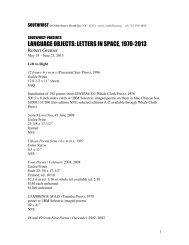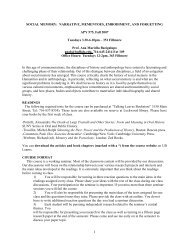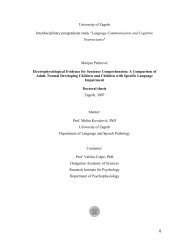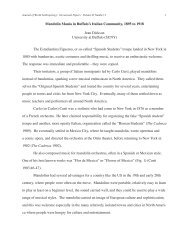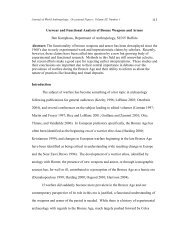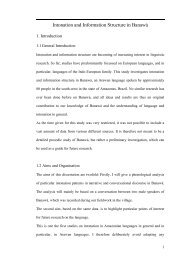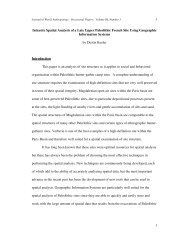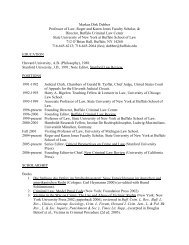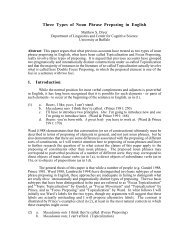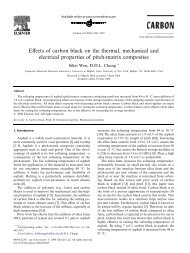What Is a Perfect State? - Wings - University at Buffalo
What Is a Perfect State? - Wings - University at Buffalo
What Is a Perfect State? - Wings - University at Buffalo
You also want an ePaper? Increase the reach of your titles
YUMPU automatically turns print PDFs into web optimized ePapers that Google loves.
<strong>Wh<strong>at</strong></strong> <strong>Is</strong> a <strong>Perfect</strong> <strong>St<strong>at</strong>e</strong>?<br />
Atsuko Nishiyama and Jean-Pierre Koenig<br />
<strong>University</strong> <strong>at</strong> <strong>Buffalo</strong>, the <strong>St<strong>at</strong>e</strong> <strong>University</strong> of New York<br />
1. Introduction<br />
The perfect is often said to introduce a st<strong>at</strong>e into the discourse (Parsons<br />
1990; Michaelis 1998; de Swart 1998). More precisely, sentences in the perfect<br />
introduces two eventualities, an event e described by the main verb and<br />
its arguments and which precedes reference time (hereafter, the prior eventuality),<br />
and a st<strong>at</strong>e s which overlaps reference time and is rel<strong>at</strong>ed to the prior<br />
eventuality e (hereafter, the perfect st<strong>at</strong>e). For example, (1) introduces the<br />
event of Ken’s breaking his leg and (1a) and (1b) are two possible perfect<br />
st<strong>at</strong>es.<br />
(1) Ken has broken his leg.<br />
a. Ken’s leg is broken.<br />
b. Ken is behind in his work.<br />
No consensus exists on the properties of the perfect st<strong>at</strong>e s and the rel<strong>at</strong>ionship<br />
between the c<strong>at</strong>egory of the perfect st<strong>at</strong>e s and the prior eventuality<br />
e has not been adequ<strong>at</strong>ely characterized. The goal of this paper is to elucid<strong>at</strong>e<br />
this rel<strong>at</strong>ion. We propose, first, th<strong>at</strong> the perfect semantically includes<br />
a free property variable for the c<strong>at</strong>egory of the perfect st<strong>at</strong>e. Secondly, we<br />
argue th<strong>at</strong> the value of this property variable is determined pragm<strong>at</strong>ically and<br />
th<strong>at</strong> the rel<strong>at</strong>ion between the prior eventuality and the perfect st<strong>at</strong>e is epistemic:<br />
The perfect st<strong>at</strong>e must be mutually inferable from the prior eventuality<br />
description through I-Implic<strong>at</strong>ures (Levinson 2000).<br />
2. Various readings of the perfect<br />
Our analysis of the perfect differs from previous analysis in th<strong>at</strong> it claims<br />
th<strong>at</strong> the perfect marker is both monosemous and a st<strong>at</strong>ivizer. Previous analyses<br />
either regarded the perfect as a st<strong>at</strong>ivizer, but argued for its ambiguity or<br />
claimed it was monosemous, but not a st<strong>at</strong>ivizer. In this section we provide<br />
a brief overview of previous accounts of the perfect. Space consider<strong>at</strong>ions<br />
prevent us from a thorough critical review of this liter<strong>at</strong>ure. Our goal in this<br />
section is more modest, lay out the various readings traditionally recognized<br />
th<strong>at</strong> our analysis must account for pragm<strong>at</strong>ically and briefly justify, when relevant,<br />
why we think the perfect is an unambiguous st<strong>at</strong>ivizer.<br />
c○ 2004 Atsuko Nishiyama and Jean-Pierre Koenig. WCCFL 23 Proceedings,<br />
ed. B. Schmeiser, V. Chand, A. Kelleher and A. Rodriguez, pp. 101–113. Somerville,<br />
MA: Cascadilla Press.
102 WCCFL 23<br />
Several different readings of the perfect have been recognized and these<br />
distinct readings follow from three possible dichotomies. The first dichotomy<br />
separ<strong>at</strong>es lexically entailed result<strong>at</strong>ive and existential perfect readings (see A<br />
in Table 1).<br />
Table 1: The classific<strong>at</strong>ions of perfect readings<br />
readings lexically entailed Implic<strong>at</strong>ed no resultant input st<strong>at</strong>e<br />
resultant st<strong>at</strong>e resultant st<strong>at</strong>e st<strong>at</strong>e continues<br />
A A Result<strong>at</strong>ive 1 Existential 2 Continu<strong>at</strong>ive<br />
B B Result<strong>at</strong>ive Existential (Universal)<br />
C C Existential<br />
D <strong>Perfect</strong><br />
A McCawley (1971), Kiparsky (2002)<br />
B Michaelis (1998)<br />
C Mittwoch (1988), Kamp and Reyle (1993), Portner (2003)<br />
1 ‘Target <strong>St<strong>at</strong>e</strong>’ perfect readings in Parsons (1990).<br />
2 ‘Resultant <strong>St<strong>at</strong>e</strong>’ perfect readings in Parsons (1990), ‘permanent st<strong>at</strong>e’ in ter Meulen<br />
(1995).<br />
The perfect in (2) can be interpreted as indic<strong>at</strong>ing th<strong>at</strong> the resultant<br />
st<strong>at</strong>e— Ken’s leg is still broken (2a)—-, lexically entailed by the verb broken,<br />
(the ‘direct resultant st<strong>at</strong>e’ of (McCawley 1971)) holds <strong>at</strong> present. Altern<strong>at</strong>ively,<br />
it can be interpreted as the existential perfect reading th<strong>at</strong> there was an<br />
instance of the event-type Ken break his leg in (2b).<br />
(2) a. Ken has broken his leg. (His leg is still broken.)<br />
b. Ken has broken his leg, but he is OK now. (His leg is cured.)<br />
The second dichotomy separ<strong>at</strong>es result<strong>at</strong>ive (whether lexically entailed<br />
or not) and existential (experiential) perfect readings (B in Table 1). Some<br />
scholars base the distinction on whether a perfect sentence has resultant st<strong>at</strong>e<br />
implic<strong>at</strong>ions or present possibility presuppositions. For example in (1), both<br />
(1a) and (1b) have resultant st<strong>at</strong>e implic<strong>at</strong>ions; those readings are therefore<br />
considered to be result<strong>at</strong>ive perfect readings. On the other hand, because<br />
existential perfect readings carry ‘present possibility’ presuppositions (Curme<br />
1935; McCawley 1971; Inoue 1979; Michaelis 1998), (3) is argued to be odd<br />
because Einstein’s visit of Princeton cannot be repe<strong>at</strong>ed <strong>at</strong> present.<br />
(3) (*)Einstein has visited Princeton.<br />
Note however th<strong>at</strong> whether or not existential perfect readings carry an idea<br />
of “present replicability”, th<strong>at</strong> constraint does not behave like a presupposi-
Nishiyama and Koenig 103<br />
tion. Whereas presuppositions can typically be neg<strong>at</strong>ed by a metalinguistic<br />
neg<strong>at</strong>ion (Horn 1985), “present replicability” seems immune to metalinguistic<br />
neg<strong>at</strong>ion. Thus, whereas the first sententence in (4) neg<strong>at</strong>es the presuppostion<br />
of the king of France’s existence; the repe<strong>at</strong>ability of the event or some<br />
construed event type rel<strong>at</strong>ed to Einstein’s visit of Princeton (Michaelis 1998)<br />
cannot be neg<strong>at</strong>ed in (5).<br />
(4) The king of France is not bald. There is no king in France.<br />
(5) *Einstein has not visited Princeton. He is not alive.<br />
Identity tests (conjunction reductions, pronominaliz<strong>at</strong>ion, ‘the same<br />
thing’-test, and so on) have sometimes been suggested as tests for the ambiguity<br />
of the perfect between a result<strong>at</strong>ive and an existential reading (McCawley<br />
1971; Michaelis 1994; Michaelis 1998). Consider sentences (6)-(8).<br />
(6) Max has been fired.<br />
(7) Max has been fired, and so has Fred.<br />
(8) Max has been fired and Fred has been fired.<br />
(6) is argued to be ambiguous, not vague, because (7) does not allow a<br />
crossed-interpret<strong>at</strong>ion. Th<strong>at</strong> is, (7) cannot be used to assert both th<strong>at</strong> Max<br />
was fired <strong>at</strong> some point in the past and th<strong>at</strong> Fred is currently out of work<br />
as a result of having been fired. However, the unreduced sentences themselves<br />
do not allow the crossed interpret<strong>at</strong>ion, as (8) shows. The absence of<br />
a crossed interpret<strong>at</strong>ion of (7) cannot therefore be <strong>at</strong>tributed to an identity-ofsense<br />
constraint on VP ellipsis (see Zwicky and Sadock (1975)). The absence<br />
of crossed interpret<strong>at</strong>ion must be due to some pragm<strong>at</strong>ic factors, r<strong>at</strong>her than<br />
semantic ambiguity, as McCoard (1978) already notes.<br />
The third dichotomy separ<strong>at</strong>es continu<strong>at</strong>ive (universal) and noncontinu<strong>at</strong>ive<br />
(existential) perfect readings of st<strong>at</strong>ive predic<strong>at</strong>ions as seen in<br />
(9) (C in Table 1).<br />
(9) Ken has been sick.<br />
a. Ken is still sick.<br />
b. Ken is not sick any more.<br />
Under a continu<strong>at</strong>ive reading (see (9a)), (9) says th<strong>at</strong> for all time intervals<br />
from a given point in the past to the present (reference time) Ken’s sickness<br />
holds. Under an existential reading, all th<strong>at</strong> (9) is saying is th<strong>at</strong> there exist one<br />
or more occurrence of the denoted situ<strong>at</strong>ion during the period from a given<br />
point in the past to the present 1 .<br />
1. Some scholars say th<strong>at</strong> continu<strong>at</strong>ive perfect readings are only available when
104 WCCFL 23<br />
Although we suggested th<strong>at</strong> they do not correspond to different meanings<br />
of the perfect, it is important to keep these various readings in mind as we<br />
present our analysis. Any adequ<strong>at</strong>e theory of the perfect must account for<br />
how these different interpret<strong>at</strong>ions arise in context.<br />
No perfect st<strong>at</strong>e?: Extended Now and other temporal theories of the perfect<br />
Not all analyses of the perfect assume th<strong>at</strong> the perfect is a st<strong>at</strong>ivizer or<br />
introduces a perfect st<strong>at</strong>e. In Extended Now (hereafter, XN) and other temporal<br />
theories of the perfect, the perfect does not introduce a st<strong>at</strong>e (McCoard<br />
1978; Inoue 1979; Klein 1992; Klein 2000; Portner 2003). The XN theory requires<br />
th<strong>at</strong> the event described in a present perfect falls within an ‘Extended<br />
Now’ time interval (McCoard 1978; Mittwoch 1988; Portner 2003). Clearly<br />
for there to be a distinction between the present perfect and a simple past<br />
tense in this view, the length of the extended now interval must be limited.<br />
Indeed, the XN theory explains th<strong>at</strong> (10) sounds odd because the event of<br />
Gutenberg’s discovery of the art of printing does not fall within an “extended<br />
now” interval, while (3) is acceptable in some contexts because the event of<br />
Einstein’s visiting Princeton can fall within an “extended now” interval (Mc-<br />
Coard 1978; Portner 2003). However, the “extended now” interval seems to<br />
be able to be quite long. (11), for example, sounds n<strong>at</strong>ural in the context of a<br />
course on the history of philosophy, even though Pl<strong>at</strong>o’s discovery happened<br />
earlier than Gutenberg’s. If the time span of “extended now” is restricted <strong>at</strong><br />
all, it does not seem th<strong>at</strong> the restriction is temporal.<br />
(10) ??Gutenberg has discovered the art of printing. (McCoard 1978; Portner<br />
2003)<br />
(11) Pl<strong>at</strong>o has discovered the existence of a priori knowledge. (Attested)<br />
Another drawback of the XN theory is th<strong>at</strong> it is not clear why have occurs<br />
in the simple present if the perfect does not describe a st<strong>at</strong>e or is not<br />
a st<strong>at</strong>ivizer. As is well-known, the English present tense is incomp<strong>at</strong>ible<br />
with episodic readings of event descriptions, except in speech acts or sports<br />
caster contexts (Michaelis 1998). No such constraint restricts the use of the<br />
present with st<strong>at</strong>e descriptions. The fact th<strong>at</strong> the perfect auxiliary have can<br />
bear present tense in episodic contexts is therefore immedi<strong>at</strong>ely accounted for<br />
under analyses of the perfect th<strong>at</strong> hypothesize it introduces a perfect st<strong>at</strong>e. It<br />
remains unexplained in the XN theory.<br />
The incomp<strong>at</strong>ibility of past time adverbials with English present perfects,<br />
is often argued to favor the XN Theory, but this incomp<strong>at</strong>ibility does<br />
the perfect cooccurs with temporal adverbial phrases such as for- or sincephrases<br />
(Mittwoch 1988). Our consultants, however, do not corrobor<strong>at</strong>e this claim.<br />
(9) can receive both continu<strong>at</strong>ive and non-continu<strong>at</strong>ive readings despite the absence of<br />
temporal adverbial phrases.
Nishiyama and Koenig 105<br />
not extend to perfects cross-linguistically 2 . For example, both German and<br />
Japanese perfects can cooccur with past time adverbials, as seen in (12) and<br />
(13), respectively.<br />
(12) Gestern um zehn habe ich den Brief abgeschickt.<br />
Yesterday <strong>at</strong> ten have I the letter sent off<br />
‘%GerI have sent off the letter <strong>at</strong> ten yesterday.’ (Klein 2000)<br />
(13) Kare-wa kyonen Kyoto-ni i- tte-i-ru.<br />
He-TOP last year Kyoto-to go TE-I-NONPAST<br />
‘%J He has been to Kyoto last year.’ 3<br />
Klein (1992) and Klein (2000) present another theory of the perfect th<strong>at</strong><br />
does not assume perfects introduce st<strong>at</strong>es. In Klein’s view, all th<strong>at</strong> the perfect<br />
introduces is a post-situ<strong>at</strong>ion temporal interval (Topic Time). But it seems th<strong>at</strong><br />
the very notion of Topic Time (TT)— an interval about which an assertion<br />
is made—, requires something like an eventuality (possibly a st<strong>at</strong>e) to be<br />
introduced by the perfect. Without anything to assert, how can there be an<br />
interval of time about which an assertion is made? When seen in this light,<br />
Klein’s theory reduces to a variant of perfect st<strong>at</strong>e theories<br />
We conclude this section with the following observ<strong>at</strong>ion. Some scholars<br />
claim th<strong>at</strong> in addition to asserting th<strong>at</strong> an eventuality occurred within the<br />
“extended now” interval, the perfect carries a presupposition th<strong>at</strong> some type<br />
of topic (or topic rel<strong>at</strong>ion) should already be in the discourse context (Inoue<br />
1979; Portner 2003). However, the fact th<strong>at</strong> a sentence containing a perfect<br />
can be uttered felicitously out of the blue, e.g., (14), suggests th<strong>at</strong> no such<br />
presupposition is <strong>at</strong>tached to the use of the perfect.<br />
(14) Prof. Smith has left his keys on the table. We should take them to<br />
him.<br />
To sum up, accounts of the perfect which do not assume its st<strong>at</strong>ivity are<br />
not entirely successful and we thereon assume the correctness of perfect st<strong>at</strong>e<br />
theories.<br />
Previous views on the perfect st<strong>at</strong>e There is considerable uncertainty on<br />
both the n<strong>at</strong>ure of the perfect st<strong>at</strong>e and its rel<strong>at</strong>ion to the prior eventuality.<br />
2. English present perfects can also co-occur with past time adverbial phrases in<br />
certain contexts.<br />
i. We have already discussed this affair <strong>at</strong> some length last night. (McCoard 1978)<br />
3. The symbols ‘%Ger ’ and ‘%J ’ mean th<strong>at</strong> the English transl<strong>at</strong>ions are not acceptable<br />
in English but the corresponding sentences are acceptable in German and<br />
Japanese, respectively.
106 WCCFL 23<br />
Some scholars have regarded the perfect st<strong>at</strong>e (s) as a st<strong>at</strong>e abutting on the<br />
described event (e) (Kamp and Reyle 1993; de Swart 1998). According to<br />
this view, the perfect st<strong>at</strong>e s starts when the prior eventuality e ends, and the<br />
abutting rel<strong>at</strong>ion between e and s is purely temporal. Others have regarded the<br />
perfect st<strong>at</strong>e as a consequent st<strong>at</strong>e resulting from e’s occurrence (Moens and<br />
Steedman 1988; Smith 1997). A causal rel<strong>at</strong>ion is assumed to exist between<br />
the prior eventuality and the perfect st<strong>at</strong>e. Finally, others regard the perfect<br />
st<strong>at</strong>e as equivalent to the permanent st<strong>at</strong>e of the event having occurred (Galton<br />
1984; ter Meulen 1995), on the basis of the fact th<strong>at</strong> the end of an event<br />
can always entail the beginning of the permanent st<strong>at</strong>e of the event’s having<br />
occurred.<br />
Difficulties plague all three models of the n<strong>at</strong>ure of the perfect st<strong>at</strong>e. We<br />
illustr<strong>at</strong>e these difficulties on the following examples.<br />
(15) Ken has broken his leg.<br />
a. His leg is broken (s)<br />
b. Ken is behind in his work (s)<br />
c. #Susan is married (s)<br />
(16) I have seen the key in this room.<br />
a. The key is in this room (s)<br />
(17) I’ve been in London since last week.<br />
a. I am in London (s)<br />
(15a), (15b), (16a) and (17a) are possible perfect st<strong>at</strong>es for (15)-(17) under<br />
the received analyses, while (15c) cannot count as a perfect st<strong>at</strong>e in normal<br />
contexts.<br />
The first view, i.e., th<strong>at</strong> the rel<strong>at</strong>ion between the prior eventuality and the<br />
perfect st<strong>at</strong>e is one of temporal abuttment cannot exclude a temporally coincidental<br />
st<strong>at</strong>e th<strong>at</strong> is unrel<strong>at</strong>ed to e. For example, it cannot exclude (15c) as<br />
a perfect st<strong>at</strong>e for (15) when the st<strong>at</strong>e of Susan’s being married starts <strong>at</strong> the<br />
very moment <strong>at</strong> which Ken’s breaking his leg ends. It cannot either generally<br />
account for implic<strong>at</strong>ed resultant st<strong>at</strong>es (Depraetere 1998) since implic<strong>at</strong>ed resultant<br />
st<strong>at</strong>es do not necessarily start when the described event ends. For example,<br />
the st<strong>at</strong>e of Ken’s being behind in his work (15b) as a resultant perfect<br />
st<strong>at</strong>e for (15) does not have to start when the event of Ken’s breaking his leg<br />
ends. The second view, i.e., th<strong>at</strong> the perfect st<strong>at</strong>e is a consequent st<strong>at</strong>e, cannot<br />
explain th<strong>at</strong> (16a) does not result from the event of the speaker’s seeing the<br />
key. In other words, the prior eventuality and the perfect st<strong>at</strong>e are not always<br />
causally rel<strong>at</strong>ed. The third view, i.e., the perfect st<strong>at</strong>e is the permanent st<strong>at</strong>e of<br />
the prior eventuality’s having occurred, cannot explain th<strong>at</strong> the perfect st<strong>at</strong>es<br />
in (15a), (15b), (16a) and (17a) are not permanent. In order to capture those
Nishiyama and Koenig 107<br />
interpret<strong>at</strong>ions, the perfect must be allowed to introduce another st<strong>at</strong>e besides<br />
th<strong>at</strong> permanent st<strong>at</strong>e. In sum, previous views on the n<strong>at</strong>ure of the perfect st<strong>at</strong>e<br />
and its rel<strong>at</strong>ion to the prior eventuality can explain some of the perfect uses,<br />
but not all. The next section proposes a unified analysis of the rel<strong>at</strong>ionship<br />
between the prior eventuality and the perfect st<strong>at</strong>e as well as of the c<strong>at</strong>egory<br />
of the perfect st<strong>at</strong>e.<br />
3. The meaning and interpret<strong>at</strong>ions of the perfect<br />
We propose th<strong>at</strong> the meaning of the perfect introduces (i) an eventuality<br />
ev, whose temporal trace precedes a reference time r (speech time n in present<br />
perfects) (τ(ev) ≺ r), and (ii) a perfect st<strong>at</strong>e s, which overlaps a reference<br />
time r (τ(s) ◦ r) and whose c<strong>at</strong>egory is inferable from the occurrence of ev.<br />
The eventuality ev can be any type of eventuality, including st<strong>at</strong>es. Within<br />
Discourse Represent<strong>at</strong>ion Theory (DRT) (Kamp and Reyle 1993; de Swart<br />
1998), Figure 1 shows the discourse represent<strong>at</strong>ion structure (DRS) of the<br />
meaning of the perfect. φ stands for the eventuality description contributed<br />
by the main verb+its arguments and the prior eventuality ev s<strong>at</strong>isfies the description<br />
φ.<br />
Figure 1: The meaning of the perfect<br />
ev, s, r<br />
φ(ev)<br />
τ(ev) ≺ r<br />
X(s)<br />
τ(s) ◦ r<br />
We also propose th<strong>at</strong> the c<strong>at</strong>egory of the perfect st<strong>at</strong>e s is semantically a<br />
free variable, as seen in (18) (X in Figure 1), which must be filled in by<br />
the addressee (see Kay and Zimmer (1978) and Partee (1984) on the use of<br />
property variables in semantics).<br />
(18) X(s)<br />
The free variable X is a semantic constraint (imposed by the perfect form),<br />
but the value of X has to be filled in via pragm<strong>at</strong>ic inferences. The only constraint<br />
on X is th<strong>at</strong> it be inferable from an occurrence of ev. The inferential<br />
process by which the value of X is determined can be modeled via the principle<br />
of inform<strong>at</strong>iveness (I-Principle) (Levinson 2000) (see also the notions of<br />
Q- and R-implic<strong>at</strong>ures in Horn (1984)). The I-principle consists of a speaker’s<br />
maxim of Minimiz<strong>at</strong>ion and a hearer’s pragm<strong>at</strong>ic enrichment as its corollary.<br />
(19) I-principle:
108 WCCFL 23<br />
1. A speaker chooses the less inform<strong>at</strong>ive utterance (q) when the more<br />
inform<strong>at</strong>ive one (p) is available (maxim of Minimiz<strong>at</strong>ion).<br />
2. The addressee enriches the less inform<strong>at</strong>ive utterance into the most<br />
specific interpret<strong>at</strong>ion, making use of world knowledge.<br />
For example, the meaning of (20) is formalized as (21). The more inform<strong>at</strong>ive<br />
utterances (21a) and (21b) are available, but when a speaker chooses<br />
to utter (20), following the maxim of Minimiz<strong>at</strong>ion, the hearer enriches the<br />
less inform<strong>at</strong>ive utterance into p or p ′ .<br />
(20) Ken has broken his leg. (=q)<br />
(21) ∃e∃s[Ken break his leg (e) ∧X(s) ∧ τ(e) ≺ n ∧ τ(s) ◦ n]<br />
a. Ken has broken his leg and Ken’s leg is broken. (=p)<br />
b. Ken has broken his leg and Ken is behind in his work. (=p ′ )<br />
We cannot detail here the reasoning process through which the value of<br />
X is inferred. We merely show how the various readings of the perfect for<br />
(20) discussed in section 2 correspond to different kinds of values X can take.<br />
For example, lexically entailed result<strong>at</strong>ive perfect readings obtain when the<br />
value of X is ‘Ken’s leg be broken,’ as shown in (22), while convers<strong>at</strong>ionally<br />
implic<strong>at</strong>ed result<strong>at</strong>ive perfect readings, i.e., non-entailed result<strong>at</strong>ive perfect<br />
readings, obtain when the value of X is, e.g, ‘Ken be behind in his work’,<br />
as seen in (23).<br />
(22) Lexically entailed result<strong>at</strong>ive perfect reading:<br />
X(s)=Ken’s leg be broken (s)<br />
(23) Convers<strong>at</strong>ionally Implic<strong>at</strong>ed result<strong>at</strong>ive perfect reading:<br />
X(s)=Ken be behind in his work (s)<br />
Existential (non-result<strong>at</strong>ive) perfect readings obtain when the value of X<br />
is, e.g., ‘Ski jumps be difficult’ or ‘Ken’s breaking his leg have occurred,’<br />
as seen in (24), depending on one’s definition of existential readings. The<br />
l<strong>at</strong>ter interpret<strong>at</strong>ion corresponds to the logical permanent st<strong>at</strong>e of an event<br />
having occurred th<strong>at</strong> we just discussed.<br />
(24) Existential (non-result<strong>at</strong>ive) perfect reading:<br />
X(s)=Ski jumps be difficult (s)<br />
X(s)=Ken’s breaking his leg have occurred (s).<br />
Finally, the value of X cannot be determined as ‘Susan be married’, because<br />
this value is not inferable from the occurrence of the event of Ken’s breaking<br />
his leg in normal contexts.<br />
(25) X(s)=#Susan be married (s)<br />
(The value is not inferable from e’s occurrence.)
Nishiyama and Koenig 109<br />
Since the meaning of the perfect can take any eventuality description ev<br />
as its input, including a st<strong>at</strong>e, when the input eventuality description is st<strong>at</strong>ive,<br />
the value of X may be of the same c<strong>at</strong>egory as th<strong>at</strong> of the prior eventuality.<br />
When this occurs— i.e., when the c<strong>at</strong>egory of the perfect st<strong>at</strong>e is th<strong>at</strong> of the<br />
prior eventuality—, we are dealing with wh<strong>at</strong> is typically labeled continu<strong>at</strong>ive<br />
perfect readings. For example, the meaning of (26), represented as (27) can<br />
lead to the I-implic<strong>at</strong>ures in (27a) and (27b) as possible perfect st<strong>at</strong>es.<br />
(26) Ken has lived in London.<br />
(27) ∃e∃s[Ken live in London (ev) ∧ X(s) ∧ τ(e) ≺ n ∧ τ(s) ◦ n]<br />
a. Ken (still) lives in London.<br />
b. Ken knows good restaurants in London.<br />
When the value of X in (27) is ‘Ken live in London,’ we are dealing<br />
with a continu<strong>at</strong>ive reading (see (28)). When the value of X is interpreted<br />
as ‘Ken know good restaurants in London,’ we are dealing with a<br />
non-continu<strong>at</strong>ive, implic<strong>at</strong>ed result<strong>at</strong>ive perfect reading (see (29)).<br />
(28) X(s)= Ken live in London (s)<br />
(29) Non-continu<strong>at</strong>ive reading:<br />
X(s)=Ken know good restaurants in London (s)<br />
Crucially, the constraint th<strong>at</strong> the c<strong>at</strong>egory of the perfect st<strong>at</strong>e be Iimplic<strong>at</strong>ed<br />
(and therefore inferable) properly excludes a temporally coincidental<br />
st<strong>at</strong>e, such as (15c) above.<br />
Our claim th<strong>at</strong> continu<strong>at</strong>ive and non-continu<strong>at</strong>ive readings of perfects of<br />
st<strong>at</strong>ive prior eventualities are pragm<strong>at</strong>ic variants and do not correspond to<br />
two distinct meanings or structures contradicts the view of Dowty (1979),<br />
Mittwoch (1988), and Portner (2003). These scholars argue th<strong>at</strong> continu<strong>at</strong>ive<br />
and non-continu<strong>at</strong>ive (existential) perfect readings involve two different<br />
structures (scopal or otherwise), because different possible positions of forphrases<br />
correl<strong>at</strong>e with these distinct readings as shown in (30).<br />
(30) a. For one year, Ken has lived in London.<br />
—(Continu<strong>at</strong>ive /??Existential)<br />
b. Ken has lived in London for one year.<br />
—(Continu<strong>at</strong>ive /Existential)<br />
However, this distinction is no more than a tendency. Existential perfect<br />
readings are sometimes possible when for-phrases are preposed. For example,<br />
(31) receives an existential perfect reading when people are talking about<br />
Ken’s field work experience.
110 WCCFL 23<br />
(31) For one year, Ken has lived in Papua New Guinea. For three months,<br />
he has lived in Malaysia.<br />
— (Existential perfect reading)<br />
We conclude th<strong>at</strong> the distinction between continu<strong>at</strong>ive and existential<br />
perfect readings does not seem to stem from a structural ambiguity reflected<br />
in the possible positions of dur<strong>at</strong>ional adverbial phrases. 4<br />
Two final remarks. First, even if the c<strong>at</strong>egory of the perfect st<strong>at</strong>e correspond<br />
to a lexical entailment of the verb, as in (22), a pragm<strong>at</strong>ic inference<br />
is still required, namely th<strong>at</strong> this st<strong>at</strong>e persists until reference time (the inference<br />
of persistence) (McDermott 1982), since there is no guarrantee th<strong>at</strong> the<br />
entailed st<strong>at</strong>e of Ken’s leg being broken continues from the end of the prior<br />
eventuality until now. Second, some perfect sentences may sound odd when<br />
finding a contextually appropri<strong>at</strong>e value for X is hard. For example, (10) may<br />
sound odd, even though some value of X can be inferred from the occurrence<br />
of the event, as seen in (32a).<br />
(32) ??Gutenberg has discovered the art of printing. (McCoard 1978:44)<br />
a. X(s) =Printing is gre<strong>at</strong> (s) (‘<strong>Is</strong>n’t printing gre<strong>at</strong>! (Portner 2003))<br />
We surmise th<strong>at</strong> the oddness of (32) follows from a general constraint<br />
on convers<strong>at</strong>ions. The only semantic constraint on the value of X is th<strong>at</strong> it<br />
be pragm<strong>at</strong>ically inferable from the occurrence of the prior eventuality. But,<br />
not all inferable values of X are convers<strong>at</strong>ionally appropri<strong>at</strong>e. Asserting both<br />
the prior eventuality and the (present) perfect st<strong>at</strong>e must make convers<strong>at</strong>ional<br />
sense. And this is wh<strong>at</strong> is hard to imagine in the case of sentences such as<br />
(32). If the discourse topic is the value of printing, mentioning th<strong>at</strong> Gutenberg<br />
discovered it five hundred years ago viol<strong>at</strong>es Grice’s relevance maxim; if the<br />
discourse centers on the history of publishing, the simple past is more appropri<strong>at</strong>e,<br />
as it typically is in narr<strong>at</strong>ives. But, as we mentioned before, and contra<br />
Portner (2003) and others, the oddity of (32) is only indirectly rel<strong>at</strong>ed to the<br />
time elapsed between the discovery and reference time. Both (33)(=(11)) and<br />
(34) are fine in the right contexts, even though the prior eventualities happened<br />
quite a while ago.<br />
4. Examples (i) and (ii) have sometimes also been adduced to support a claim of<br />
ambiguity between continu<strong>at</strong>ive and existential perfect readings. According to this<br />
view, existential perfects such as (i) allow both the simultaneity of the events described<br />
by the main and embedded clause or the precedence of the event described by the<br />
embedded clause. In contrast, continu<strong>at</strong>ive perfects such as (ii) are claimed to disallow<br />
the simultaneity of the events described by the main and embedded clauses.<br />
i. Since Chrismas, Ken has claimed th<strong>at</strong> his wife was sick.<br />
ii. Since Chrismas, Ken has been claiming th<strong>at</strong> his wife was sick.<br />
Our consultants disagreed. Both continu<strong>at</strong>ive perfect uses as well as existential perfect<br />
uses allow both simultaneous (overlapping) and shifted readings.
Nishiyama and Koenig 111<br />
(33) Pl<strong>at</strong>o has discovered the existence of a priori knowledge. (Attested:http://www.fiu.edu/˜<br />
hermanso/over9)<br />
(34) Beethoven has not done all this for the sake of producing something<br />
longer, more noisy, more full of tunes and more complex than any<br />
symphony before. He has consciously <strong>at</strong>tempted within the general<br />
p<strong>at</strong>tern of the symphony, to express a predetermined range of<br />
emotions. He has tried to make the symphony a vehicle for intense<br />
personal feeling about something. (Attested:http://www.stand.demon.co.uk/JBSoc/journal/apr<br />
99/beet.html )<br />
4. Conclusion<br />
Theories of the perfect th<strong>at</strong> tre<strong>at</strong> it as a st<strong>at</strong>ivizer very often claim th<strong>at</strong> it<br />
is ambiguous and do not s<strong>at</strong>isfactorily elucid<strong>at</strong>e the properties of th<strong>at</strong> st<strong>at</strong>e.<br />
This paper proposes a unified analysis of all uses of the perfect. It argues<br />
th<strong>at</strong> the perfect does introduce a perfect st<strong>at</strong>e, but one whose c<strong>at</strong>egory is<br />
semantically unspecified and must be determined pragm<strong>at</strong>ically through Iimplic<strong>at</strong>ures.<br />
More generally, our analysis shows how semantic and pragm<strong>at</strong>ic<br />
factors interact to lead to the various perfect uses in a way th<strong>at</strong> parallels<br />
both the analysis of English nominal compound semantics (Kay and Zimmer<br />
1978; Partee 1984) and the pragm<strong>at</strong>ic processes underlying reference resolution<br />
(Clark 1992).<br />
References<br />
CLARK, HERBERT H. 1992. Arenas of Language Use. Chicago: The <strong>University</strong><br />
of Chicago Press.<br />
CURME, GEORGE OLIVER. 1935. Parts of speech and accidence. Boston,<br />
New York: D.C. He<strong>at</strong>h.<br />
DE SWART, HENRIËTTE. 1998. Aspect shift and coercion. N<strong>at</strong>ural Language<br />
and Linguistics Theory 16.347–385.<br />
DEPRAETERE, ILSE. 1998. On the result<strong>at</strong>ive character of present perfect<br />
sentences. Journal of Pragm<strong>at</strong>ics 29.597–613.<br />
DOWTY, DAVID R. 1979. Word meaning and Montague grammar : the<br />
semantics of verbs and times in gener<strong>at</strong>ive semantics and in Montague’s<br />
PTQ. Dordrecht ; Boston: D. Reidel Pub. Co.<br />
GALTON, ANTONY. 1984. The logic of aspect : an axiom<strong>at</strong>ic approach.<br />
Oxford New York: Clarendon Press ; Oxford <strong>University</strong> Press.<br />
HORN, LAURENCE R. 1984. Toward a new taxonomy for pragm<strong>at</strong>ic inference:<br />
Q-based and r-based implic<strong>at</strong>ure. Meaning, form and use in
112 WCCFL 23<br />
context: Linguistic applic<strong>at</strong>ions, ed. by Deborah Schiffrin, 11–42. Washington,<br />
DC: Georgetown <strong>University</strong> Press.<br />
—— 1985. Netalinguistic neg<strong>at</strong>ion and pragm<strong>at</strong>ic ambiguity. Language<br />
61.121–174.<br />
INOUE, KYOKO. 1979. An analysis of the English present perfect. Linguistics<br />
17.561–589.<br />
KAMP, HANS, and UWE REYLE. 1993. From Discourse to Logic, Part1, 2.<br />
Dordrecht: Kluwer Academic Press.<br />
KAY, PAUL, and KARL ZIMMER. 1978. On the semantics of compounds<br />
and genitives in English. Sixth California Linguistics Associ<strong>at</strong>ion, ed.<br />
by R. Underhill, San Diego. Campanile.<br />
KIPARSKY, PAUL. 2002. Event structure and the perfect. The construction<br />
of meaning, ed. by David Beaver, Luis D. CAsillas Martínez, Brady Z.<br />
Clark, and Stefan Kaufmann, 113–135. Stanford: CSLI Public<strong>at</strong>ions.<br />
KLEIN, WOLFGANG. 1992. The present perfect puzzle. Language 68.525–<br />
552.<br />
——. 2000. An analysis of the german perfekt. Language 76.358–382.<br />
LEVINSON, STEPHEN C. 2000. Presumptive Meanings: The Theory of<br />
Generalized Convers<strong>at</strong>ional Implic<strong>at</strong>ure. Cambridge: MIT press.<br />
MCCAWLEY, JAMES D. 1971. Tense and time reference in English. Studies<br />
in linguistic semantics, ed. by C. J. Fillmore and D. T. Langendoen.<br />
NewYork: Holt, Rinehart, and Winston.<br />
MCCOARD, ROBERT. 1978. The English <strong>Perfect</strong>: Tense Choice and Pragm<strong>at</strong>ic<br />
Inferences. Amsterdam: North-Holland Publishing Company.<br />
MCDERMOTT, DREW. 1982. A temporal logic for reasoning about processes<br />
and plans. Cognitive Science 6.101–155.<br />
MICHAELIS, LAURA A. 1994. The ambiguity of the English present perfect.<br />
Journal of Linguistics 30.111–157.<br />
—— 1998. Aspectual grammar and past-time reference. London ; New York:<br />
Routledge.<br />
MITTWOCH, ANITA. 1988. Aspects of English aspect: On the interaction of<br />
perfect, progressive and dur<strong>at</strong>ional phrases. Linguistics and Philosophy<br />
11.203–254.<br />
MOENS, MARC, and MARK STEEDMAN. 1988. Temporal ontology and<br />
temporal reference. Comput<strong>at</strong>ional Linguistics 14.15–28.<br />
PARSONS, TERENCE. 1990. Events in the Semantics of English. Cambridge:<br />
The MIT Press.<br />
PARTEE, BARBARA. 1984. Compositionality. Varieties of formal semantics:<br />
Proceedings of the fourth Amsterdam colloquium, ed. by Frank Veltman,<br />
281–311. Dordrecht: Foris Public<strong>at</strong>ions.<br />
PORTNER, PAUL. 2003. The (temporal) semantics and (modal) pragm<strong>at</strong>ics<br />
of the perfect. Linguistics and Philosophy 26.459–510.
Nishiyama and Koenig 113<br />
SMITH, CARLOTA S. 1997. The parameter of aspect (second edition). Dordrecht<br />
; Boston: Kluwer, 2nd edition.<br />
TER MEULEN, ALICE G.B. 1995. Representing Time in N<strong>at</strong>ural Language:<br />
The Dynamic Interpret<strong>at</strong>ion of Tense and Aspect. Cambridge: The MIT<br />
Press.<br />
ZWICKY, ARNOLD M., and JERROLD M. SADOCK. 1975. Ambiguity tests<br />
and how to fail them. Syntax and semantics, vol. 4, ed. by P. Kimball,<br />
1–36. New York: Academic Press.




